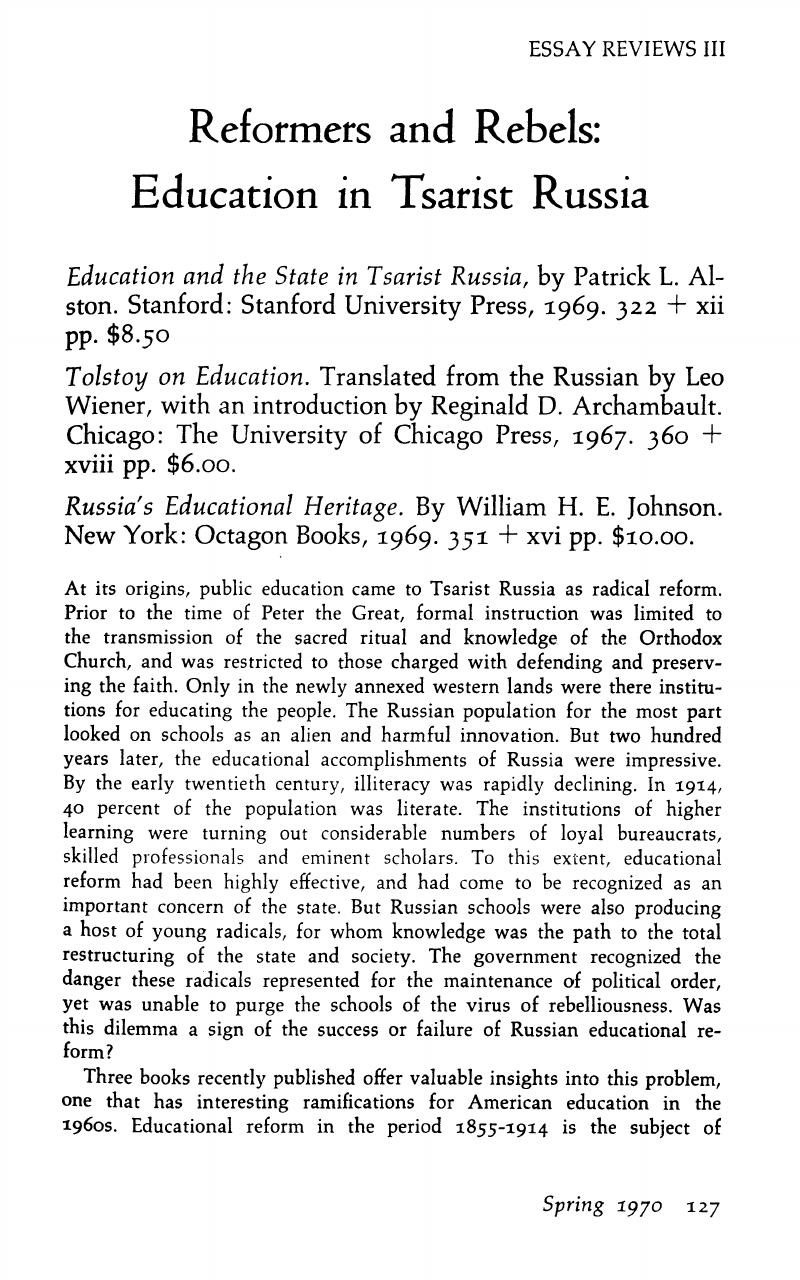No CrossRef data available.
Published online by Cambridge University Press: 24 February 2017

1. See Bissonnette, Georges, “Peter the Great and the Churches as an Educational Institution,” in Essays in Russian and Soviet History, ed. Curtiss, John (New York: Columbia University Press, 1963), pp. 3–19.Google Scholar
2. Johnson, , p. 50.Google Scholar
3. Both Johnson, and Alston, prefer the less pretentious, loose translation “Ministry of Education.”Google Scholar
4. Ringer, Fritz, “Higher Education in Germany,” in Education and Social Structure in the Twentieth Century, ed. Laqueur, Walter and Mosse, George L. (New York: Harper & Row, Publishers, 1967), p. 132.Google Scholar
5. Quoted in Alston, , p. 177.Google Scholar
6. Hans, Nicholas, History of Russian Educational Policy, 1701-1917 (New York: Russell & Russell, Publishers, 1964), chap. V.Google Scholar
7. See Sinel, Allen, “Educating the Peasantry: The Elementary School Reforms of Count Dimitrii Tolstoi,” Slavic Review, XXVII (March 1968), 49–70.Google Scholar
8. His activities are mentioned briefly in Alston, , p. 104. A very flattering survey of his activities is A. V. Kleiankin, “Il'Ia Nikolaevich Ul'Ianov,” Voprosy istorii (June 1967), pp. 145-54.Google Scholar
9. Tolstoy, , p. 94.Google Scholar
10. Rashin, A., “Gramotnost' i narodnoe obrazovanie v Rossii v XIX i v nachale XX vekakh” [Literacy and public education in Russia in the nineteenth and the beginning of the twentieth century], Istoricheskie zapiski, 1951, p. 51.Google Scholar
11. For a discussion of the education of Russian nobles in the eighteenth century, see Marc Raeff, Origins of the Russian Intelligentsia: The Eighteenth-Century Nobility (New York: Harcourt, Brace & World, Publishers, 1966), chap. IV.Google Scholar
12. Cited in Miller, Forrest, Dimitri Miliutin and the Reform Era in Russia (Nashville: Vanderbilt University Press, 1968), p. 95.Google Scholar
13. Ibid., p. 90.Google Scholar
14. Johnson, , Table 35, p. 290.Google Scholar
15. See Vucinich, Alexander, Science in Russian Culture: A History to 1860 I (Stanford University Press, 1963), esp. part III.Google Scholar
16. The most complete study in English of this movement in Reginald Zelnick, “The Sunday-School Movement in Russia, 1859-1862,” The Journal of Modern History, XXXVII (June 1965), 151–70.CrossRefGoogle Scholar
17. A capsule history of these events is in Johnson, pp. 148-49.Google Scholar
18. Tolstoy, , p. 221.Google Scholar
19. Ibid., p. 29.Google Scholar
20. Ibid., pp. 136-37.Google Scholar
21. Kropotkin, Peter, Memoirs of a Revolutionist (Gloucester, Mass.: Peter Smith, 1967), part IV.Google Scholar
22. Johnson, , pp. 150–51.Google Scholar